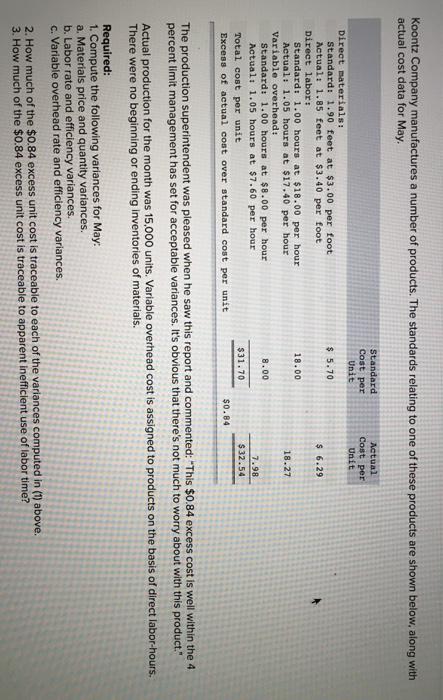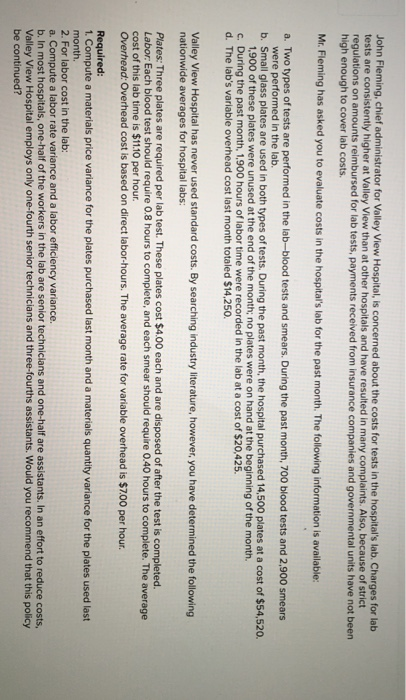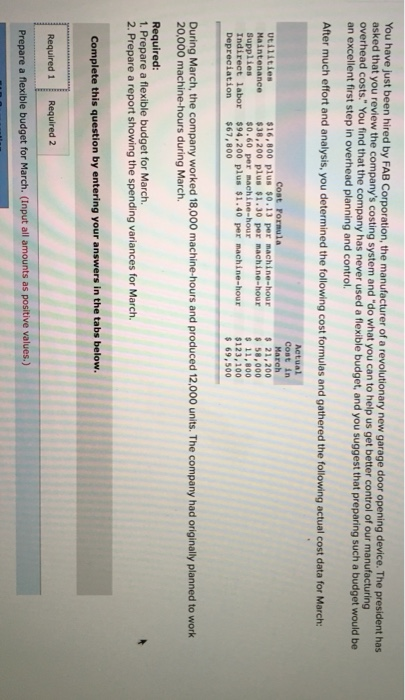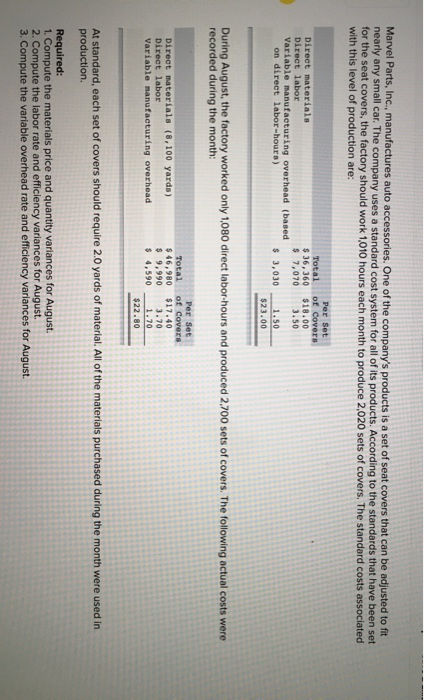Koontz Company manufactures a number of products. The standards relating to one of these products are shown below, along with actual cost data for May. Standard Cost per Unit Actual Cost per Unit $ 5.70 $ 6.29 18.00 Direct materials: Standard: 1.90 feet at $3.00 per foot Actual: 1.85 feet at $3.40 per foot Direct labor: Standard: 1.00 hours at $18.00 per hour Actual: 1.05 hours at $17.40 per hour Variable overhead: Standard: 1.00 hours at $8.00 per hour Actual: 1.05 hours at $7.60 per hour Total cost per unit Excess of actual cost over standard cost per unit 8.00 $31.70 7.98 $32.54 $0.84 The production superintendent was pleased when he saw this report and commented: "This $0.84 excess cost is well within the 4 percent limit management has set for acceptable variances. It's obvious that there's not much to worry about with this product." Actual production for the month was 15,000 units. Variable overhead cost is assigned to products on the basis of direct labor-hours. There were no beginning or ending inventories of materials. Required: 1. Compute the following variances for May: a. Materials price and quantity variances. b. Labor rate and efficiency variances. c. Variable overhead rate and efficiency variances. 2. How much of the $0.84 excess unit cost is traceable to each of the variances computed in (1) above. 3. How much of the $0.84 excess unit cost is traceable to apparent inefficient use of labor time? John Fleming, chief administrator for Valley View Hospital, is concerned about the costs for tests in the hospital's lab. Charges for lab tests are consistently higher at Valley View than at other hospitals and have resulted in many complaints. Also, because of strict regulations on amounts reimbursed for lab tests, payments received from insurance companies and governmental units have not been high enough to cover lab costs. Mr. Fleming has asked you to evaluate costs in the hospital's lab for the past month. The following information is available: a. Two types of tests are performed in the lab-blood tests and smears. During the past month, 700 blood tests and 2,900 smears were performed in the lab. b. Small glass plates are used in both types of tests. During the past month, the hospital purchased 14,500 plates at a cost of $54,520. 1,900 of these plates were unused at the end of the month; no plates were on hand at the beginning of the month. c. During the past month, 1,900 hours of labor time were recorded in the lab at a cost of $20,425. d. The lab's variable overhead cost last month totaled $14,250. Valley View Hospital has never used standard costs. By searching industry literature, however, you have determined the following nationwide averages for hospital labs: Plates: Three plates are required per lab test. These plates cost $4.00 each and are disposed of after the test is completed. Labor: Each blood test should require 0.8 hours to complete, and each smear should require 0.40 hours to complete. The average cost of this lab time is $11.10 per hour. Overhead: Overhead cost is based on direct labor-hours. The average rate for variable overhead is $7.00 per hour. Required: 1. Compute a materials price variance for the plates purchased last month and a materials quantity variance for the plates used last month. 2. For labor cost in the lab: a. Compute a labor rate variance and a labor efficiency variance. b. In most hospitals, one-half of the workers in the lab are senior technicians and one-half are assistants. In an effort to reduce costs. Valley View Hospital employs only one-fourth senior technicians and three-fourths assistants. Would you recommend that this policy be continued? You have just been hired by FAB Corporation, the manufacturer of a revolutionary new garage door opening device. The president has asked that you review the company's costing system and "do what you can to help us get better control of our manufacturing overhead costs." You find that the company has never used a flexible budget, and you suggest that preparing such a budget would be an excellent first step in overhead planning and control. After much effort and analysis, you determined the following cost formulas and gathered the following actual cost data for March: Utilities Maintenance Supplies Indirect labor Depreciation Cost Formula $16,800 plus $0.13 per machine-hour $38,200 plus $1.30 per machine-hour $0.60 per machine-hour $94,200 plus $1.40 per machine-hour $67,800 Actual Cost in March $ 21,200 $ 58,000 $ 11,800 $123, 100 $ 69,500 During March, the company worked 18,000 machine-hours and produced 12,000 units. The company had originally planned to work 20,000 machine-hours during March. Required: 1. Prepare a flexible budget for March. 2. Prepare a report showing the spending variances for March. Complete this question by entering your answers in the tabs belo Required 1 Required 2 Prepare a flexible budget for March. (Input all amounts as positive values.) Marvel Parts, Inc., manufactures auto accessories. One of the company's products is a set of seat covers that can be adjusted to fit nearly any small car. The company uses a standard cost system for all of its products. According to the standards that have been set for the seat covers, the factory should work 1,010 hours each month to produce 2,020 sets of covers. The standard costs associated with this level of production are: Direct materials Direct labor Variable manufacturing overhead (based on direct labor-hours) Total $36, 360 $ 7,070 Per Set of Covers $18.00 3.50 $ 3,030 1.50 $23.00 During August, the factory worked only 1,080 direct labor-hours and produced 2,700 sets of covers. The following actual costs were recorded during the month: Direct materials (8,100 yards) Direct labor Variable manufacturing overhead Total $ 46,980 $ 9,990 $ 4,590 Per Set of Covers $17.40 3.70 1.70 At standard, each set of covers should require 2.0 yards of material. All of the materials purchased during the month were used in production. Required: 1. Compute the materials price and quantity variances for August. 2. Compute the labor rate and efficiency variances for August. 3. Compute the variable overhead rate and efficiency variances for August










